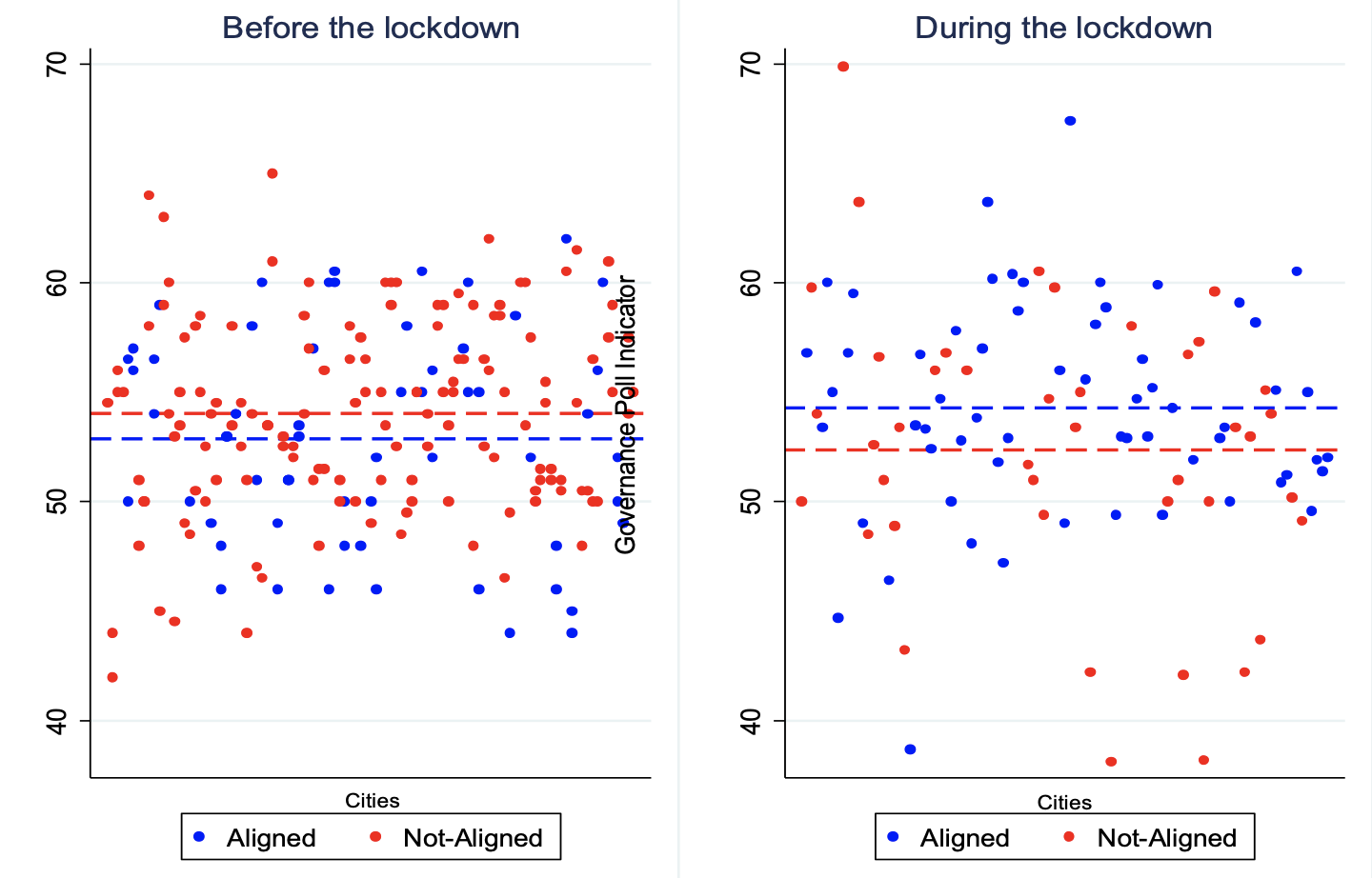During the first wave of the COVID-19 outbreak, many central governments proclaimed a national state of emergency, which entitled them to take any relevant measure to solve the crisis caused by the pandemic. Since then, leveraging their increased centralised authority and in order to control the reproduction rate of the novel coronavirus, governments progressively announced several measures that closed schools and universities, public spaces, non-essential businesses, and economic activities, along with restricting the movements of individuals (Baldwin and di Mauro 2020).
While it is widely recognised in the literature that in a crisis a centralised decision-making system is more efficient than a multi-level political architecture of governance (Boin and ‘t Hart 2003) because centralised decisions allow prompt and urgent responses to be taken (Perrow 1967), the consequences of this sharp change in voters’ ability to attribute policymaking responsibilities – and hence to judge them – to the correct level of government have not been deeply explored yet. Indeed, upon realising the effect of a policy, voters cannot be entirely sure that it has been enacted by a specific government level, and this might become particularly difficult when a decision-making process sharply changes, as occurred during the first wave of the COVID-19 outbreak.
Not surprisingly, there is still limited systematic evidence on how citizens have evaluated the policy responses taken by governments during the first wave of the pandemic (Herrera et al. 2020). According to one perspective, citizens might not be able to understand the policymaking process in sufficient detail to accurately attribute responsibility for its outcomes, and hence cannot judge the government’s management and tackling of the crisis (Healy and Malotra 2009). Alternatively, citizens may be perfectly able to identify who to blame or praise for policy outcomes (Fortunato et al. 2020), and therefore might punish (the ‘disillusion effect’, as in Daniele et al. 2020) or reward (the ‘rally around the flag effect’, as in Blais et al. 2020) the incumbent government.
The quasi-experimental design
In a recent work, we exploit the change in the decision-making system induced by the pandemic to study voters’ attributions of policymaking influence (Ferraresi and Gucciardi 2020). Specifically, we rely on a panel of 103 large cities in Italy (all provincial capitals) observed in three waves (2015, 2017, and 2020) and take advantage of the political alignment of the city council to the central government to implement a difference-in-differences research design. We posit that politically aligned cities are expected to be more influenced by the change in the decision-making process, as voters in these cities might find it more difficult to separate and clearly identify the attribution of activities and responsibilities between the central and local governments, as they share the same ruling party. For voters in non-aligned cities, such responsibilities might be easier to separate.
The local governance poll indicator
To proxy the policymaking influence that voters expect each mayor/municipal council to exert, we adopt the governance pool indicator, a periodic poll on the public’s approval of their mayors (and the municipal councils). This indicator ranges from 0 to 100 and represents a local measure of ‘political’ performance. We compare the difference in the governance poll score between aligned and non-aligned cities before the pandemic, when policy outcomes were unambiguously attributed to the local policymaker, with the same difference during the COVID-19 outbreak, when decisions were fully centralised.
Results
We find that that before the pandemic, the average value of the municipal governance poll score obtained by aligned cities (54.029) was higher than that of non-aligned ones (52.869), with a difference equal to 1.160. Since the COVID-19 outbreak, when policy decisions became centralised, the same difference has become negative (–1.914). It then follows that the difference in the differences is negative (–3.074 = –1.914 – 1.160), suggesting that during times of emergency the perception of local government actions drastically reduces when central and local governments are ‘nested’ – that is, when they belong to the same party coalition.
Figure 1 Difference-in-differences estimates of the effect of lockdown on team performance
Note: The dashed lines indicate the average value of the governance poll indicator for politically aligned (blue) and non-aligned (red) cities before (2015 and 2017) and during the lockdown (2020) in the first wave of the pandemic
Citizen blind spots or disapproval of the central government?
The key question is then whether such a decrease is due to the fact that citizens are temporarily unable to accurately attribute responsibility for policy outcomes or, instead, the drop in the governance indicator reflects a negative perception of the policies adopted by the central government during the COVID-19 outbreak.
To answer to this question, we split the alignment variable into two separate components. On the one hand, we define as ‘aligned with the central government’ those cities whose mayoral coalition is the same as the coalition in power at the central level but not at the regional government level. On the other hand, we define as ‘aligned with the regional government’ those cities whose mayoral coalition is the same as the coalition in power at the regional level but not at the national government level. If citizens are confused regarding policy attribution, both alignment variables would be negative and significant. If the decline in the governance indicator observed in aligned cities instead captures negative perceptions of the policies adopted by the central government, we would observe a negative effect associated with municipalities aligned only with the government and no effect for cities aligned with the regional council. Our results indicate that the reduction in the governance indicator is not because citizens suffer from ‘blind spots’ that cause them to misattribute policy responsibility; rather, the decrease seems to be driven by a sort of ‘punishment’ for the policy decisions of the central government, which might reflect a sense of a lack of government preparedness against the pandemic
Implications
Despite many limitations of these findings, it emerges that politically aligned cities appear to be more affected by citizens’ perceptions of the government’s response to a crisis. More specifically, if policies adopted by the central government are unpopular or if there is an impression of a lack of government preparedness against the pandemic, such a (negative) perception is exacerbated in cities whose mayor shares the same political affiliation as the central government. This last finding calls for extra attention on how the government will handle subsequent waves of the pandemic. If this negative attitude continues to hold, there might be a risk that such a ‘discontent’ sentiment will be channelled into some form of populism across European countries, as documented by Daniele et al. (2020b) and Herrera et al. (2020).
Authors’ note: The scientific output expressed does not imply a policy position of the European Commission. Neither the European Commission nor any person acting on behalf of the Commission is responsible for the use which might be made of this column.
References
Baldwin, R and B Weder di Mauro (2020), Mitigating the COVID economic crisis: Act fast and do whatever it takes, CEPR Press.
Blais, A, D Bol, M Giani and P J Loewen (2020), “COVID-19 lockdowns have increased support for incumbents, trust in government, and satisfaction with democracy”, VoxEU.org, 7 May.
Boin, A and P ‘t Hart (2003), “Public leadership in times of crisis: Mission impossible?”, Public Administration Review 63: 544–553.
Daniele, G, A F Martinangeli, F Passarelli, W Sas and L Windsteiger (2020a), “Wind of Change? Experimental Survey Evidence on the COVID-19 Shock and Socio-Political Attitudes in Europe”, Covid Economics 44.
Daniele, G, A F Martinangeli, F Passarelli, W Sas and L Windsteiger (2020b), “Covid-19 and socio-political attitudes in Europe: In competence we trust”, VoxEU.org, 1 October.
Ferraresi, M and G Gucciardi (2020), “Centralisation, voter perception, and the sense of government unpreparedness during the COVID-19 pandemic in Italy”, Covid Economics 60.
Fortunato, D, N C Lin, R T Stevenson and M W Tromborg (2020), “Attributing Policy Influence under Coalition Governance”, American Political Science Review 1–17.
Healy, A and N Malhotra (2013), “Retrospective voting reconsidered”, Annual Review of Political Science 16: 285–306.
Herrera, H, M Konradt, G Ordonez and C Trebesch (2020), “The political consequences of the Covid pandemic: Lessons from cross-country polling data”, VoxEU.org, 6 November.
Perrow, C (1967), “A framework for the comparative analysis of organizations”, American Sociological Review 32(2): 194–208




